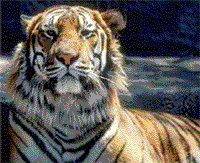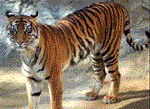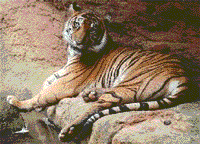 CATS
CATS CATS
CATS
Common Name: Marbled cat
Family: FELIDAE
Scientific Name: Felis mamorate charltoni
Bangla Name: Marbel Biral
A cat similar to the leopard cat but the skull is rather short, broadened and rounded. Ground colour yellowish grey with black or reddish brown blotches and stripes scattered over the entire body, marbling more prevalent on the neck and flank, spots on the limbs, tail and whitish underparts very much resemble a clouded leopard. Head and body 58 cm, tail 38 cm and weighs 3.5 kg. Its presence in Bangladesh is doubtful and there appears no sight record. It is assumed to be present in the hilly forests of Sylhet, Chittagong or Hill Tracts district.
Common Name: Golden cat
Family: FELIDAE
Scientific Name: Felis temmincki temmincki
Bangla Name: Shonali Biral
Rather a spotless cat, much larger than domestic ones. Overall colour golden or reddish brown, with a white or yellow horizontal stripe on the cheek often bordered by black line, a grey or white line on innersides of the eyes bifurcates on the forehead and runs up to the crown, remaining parts of the body is without any spots or markings. Head and body 35 cm, tail 45 cm, height at the shoulder 53 cm, weight 10 kg. Body colour and head-face markings are diagnostic.
Mitra (1957) reported it from the Chittagong region and Dr. Reza Khan have collected the only specimen of the species from the Rangamati area of Hill Tracts district. It is probably a very rare creature.
Common Name: Fishing cat
Family: FELIDAE
Scientific Name: Felis viverrinus
Bangla Name: Mecho Biral / Mecho Bagh
 A heavily
built cat with short legs. Overall body colour greyish yellow with series of vertical
blackish or deep yellow stripes, greyish cheek with two oblique bars, several lines
running from forehead to nape, sides, underparts and limbs are spotted, toes of forefeet
webbed. Head and body 90 cm, tail 30 cm, and weighs 12 kg. The webbed foretoes and body
markings are characteristic.
A heavily
built cat with short legs. Overall body colour greyish yellow with series of vertical
blackish or deep yellow stripes, greyish cheek with two oblique bars, several lines
running from forehead to nape, sides, underparts and limbs are spotted, toes of forefeet
webbed. Head and body 90 cm, tail 30 cm, and weighs 12 kg. The webbed foretoes and body
markings are characteristic.
The fishing cat is still common and widely distributed in the country. In the absence of tiger and leopard in the countryside this cat has earned the reputation of being a goat and baby lifter. It may be found anywhere outside the city limits, usually behind the dwelling houses amongst the thickets. It is very common in the Sunderbans.
Common Name: Leopard cat
Family: FELIDAE
Scientific Name: Felis bengalensis bengalensis
Bangla Name: Chita Biral
A miniature version of the leopard, having the size of a domestic cat but with longer limbs. It has a yellowish back and whitish underparts, black or yellow round spots all over the body, head and back has some black stripes, a pair of horizontal cheek-stripe is distinct, there are spots on the terminal portion of the tail forming bars. Head and body 60 cm, tail 30 cm, and weighs 4 kg.
Its a forest dwelling animal and is often met along the periphery at dawn and dusk. It isalso present in the tea gardens of Sylhet and Chittagong. Possibly it did not reach the Sundarbans and other mangrove formations and is not common anywere. Sometimes found in the pet-trade market at Chittagong.
Common Name: Jungle cat
Family: FELIDAE
Scientific Name: Felis chaus kutas
Bangla Name: Ban biral / Waab
Larger and heavier than the domestic cat with comparatively short tail and long limbs. Overall reddish yellow or greyish yellow body colour, with no distinct spots or markings but may have some stripes on underside and flanks. The tail has black terminal rings and tip, paws yellow, ears reddish with black hairs on the apex, eyes faded green. Head and body 60 cm, tail 23 cm and weighs 6 kg. Spotless body, greenish eyes and tail markings are diagnostic.
It has the widest distribution among the cats. It is likely to be present in all the forest types, including the Sundarbans and other coastal forests. Several specimens were shot In Dhaka city during the eighties. This cat usually lives in the scrub jungle, scattered forest, graveyard and thickets in the villages, and of course, in the natural forests.
Common Name: Leopard
Scientific Name: Panthera pardus fusca
Bangla Name: Chitabagh
The Bengali name often confuses the leopard with the African Cheetah, which is already extinct in Asia. The Bengali name aptly describesthe spotted coat of the leopard. Over all colour of the back is similar to the tigers yellowish or orange and has almost an evenly distributed small close set black rosettes instead of black stripes of the tiger or black spots of cheetah. The underpart is pale white, the tail has black spots plus a couple of black rings around the tip. Total length from the nose tip to thei tail tip for males is 215 cm and females 180 cm; the weight is 68 kg and 50 kg respectively. Height at shoulder is 60 cm, tail is from 1/2 to 3/4 th of the length from nose tip to rump, which is comparatively larger than the tigers.
The Leopard had a wide distribution in the past, except that it may not have reached the Sundarbans. The leopard was last sighted at the Madhupur National Park around 1962 (Fr. Eugene Homrich), in the West Banugach forest of Sylhet around the sixties. A villager shot a leopard near Barog bridge of Ejajnagar at Tetulia, under Dinajpur in 1979. Now it is very rare and even rarer than the tiger, it has completely disappeard from the areas West of 90' E and the sal forests belt. A small number still exists in the tea garden and in the forests of Sylhet, Chittagong and Hill Tracts.
Common Name: Royal Bengal Tiger
Scientific Name: Panthera tigris tigris
Bangla Name: Bagh / Dorabagh
Bangladeshis know it as the'Royal Bengal Tiger'. Its the most
magnificient and majestic and one of the most colourful of the animals. It has a rich
yellow to orange body colour with blackish vertically arranged stripes over the entire
body, more pronounced towards the rump and thighs. The underparts and innersides of the
limbs whitish yellow and the tail has a series of black rings, the forelimbs have less
stripe than the hindlimbs, back of the ears black with a distinct white patch. The pug
marks of forefoot are much bigger, broader and more spherical than the hind-foot and are
always a bit ahead of the hind-foot. The difference between the sizes of the pugmarks of
the fore and hind-feet of a tigress  is less pronounced than the male tiger. A tiger averages 300 cm from tip of
nose to the tip of the tail, the tail being 90 cm or so, weight 200 kg. A tigress measures
260 cm in length, 160 kg in weight. Height at the shoulder is little less than a metre,
about 95 cm or so.
is less pronounced than the male tiger. A tiger averages 300 cm from tip of
nose to the tip of the tail, the tail being 90 cm or so, weight 200 kg. A tigress measures
260 cm in length, 160 kg in weight. Height at the shoulder is little less than a metre,
about 95 cm or so.
According to the Eastern Bengal District Gazetteers of the pre-forties,
Mitra (1957) and Husain (1974) the tiger was distributed over entire  Bangladesh in suitable habitats. The then jamindars
of Suseng-Durgapur and Muktagacha of Mymensingh shot their last tigers from the Mudhupur
tracts of the sal forest in the early forties (Dr. Lahiri Chowdhury). The last tiger of
West Bhanugach forest of Sylhet was shot by an army general in the late fifties and that
of the Mainimukh area of Hill Tracts North FD, along Kassalong valley, in October 1950
(Ahmed 1981). It was fun for the sylhettis (people of the district of Sylhet) to trap and
kill tigers with the help of very long nets, spears and gigs amidst drum-boating and lot
of amusements around 1940s (Prof. Dwijen Sharma). Gen. M. A. G. Osmani shot the last tiger
of Banglabandha, Tetulia P.S. in 1962 ( Hasan Ali Miah). But the tiger has disappeared
from most parts of Bangladesh except the mangrove forest of the Sunderbans in Khulna
District where there is still a viable population of some 300 to 400 tigers. Stray tigers
have been found in Mymensingh North sal forest and Fashiakhali Range of Chittagong
district. Two tigers have been shot in the recent past, one tiger strayed in to Sylhet and
was shot in 1985.
Bangladesh in suitable habitats. The then jamindars
of Suseng-Durgapur and Muktagacha of Mymensingh shot their last tigers from the Mudhupur
tracts of the sal forest in the early forties (Dr. Lahiri Chowdhury). The last tiger of
West Bhanugach forest of Sylhet was shot by an army general in the late fifties and that
of the Mainimukh area of Hill Tracts North FD, along Kassalong valley, in October 1950
(Ahmed 1981). It was fun for the sylhettis (people of the district of Sylhet) to trap and
kill tigers with the help of very long nets, spears and gigs amidst drum-boating and lot
of amusements around 1940s (Prof. Dwijen Sharma). Gen. M. A. G. Osmani shot the last tiger
of Banglabandha, Tetulia P.S. in 1962 ( Hasan Ali Miah). But the tiger has disappeared
from most parts of Bangladesh except the mangrove forest of the Sunderbans in Khulna
District where there is still a viable population of some 300 to 400 tigers. Stray tigers
have been found in Mymensingh North sal forest and Fashiakhali Range of Chittagong
district. Two tigers have been shot in the recent past, one tiger strayed in to Sylhet and
was shot in 1985.
Common Name: Clouded leopard
Family: Felidae
Scientific Name: Neofelis nebulosa marcrosceloides
Bangla Name: Lamchita / Gechobagh
Clouded leopard is a colourful, long-bodied, long-tailed and short-limbed tree-dwelling cat. It is very similar in colouring and coat pattern to the smaller, unrelated marbled cat. Entire body is yellow brown with blackish stripes and blotches and the tail having both distinct black complete and incomplete rings. The underside whitish with or without a wash of yellow, two broad stripes run down from between the ears to the back. A rather short-legged cat, the clouded leopard has a long head and a large and strong upper-canine teeth that are proportionately longer than those of any other cat. Total length is 180 cm, the tail measuring about 4/5th of this, height at shoulder is 80 cm and weighs 20 kg. The female of the species is smaller than the male. It is reported to be nocturnal and to live in trees; it preys on birds and on small mammals, such as pigs and monkeys.
A good population of clouded leopard once occurred all over the forested belts of Sylhet, Chittagong and Hill Tracts districts, but the population has declined and it is now a rare animal found mostly in the Hill Tracts North and South FD. The fur trade market at Chittagong is literally flooded with clouded leopard skins, locally called "Kolagaichcha's". By 1985 the stocks have been taken underground and it is believed to be a commodity of the flourishing smuggling market.